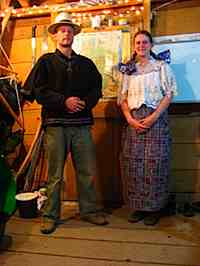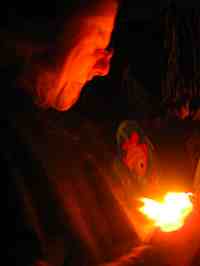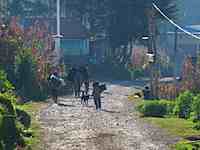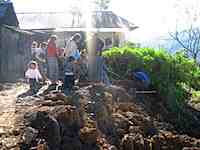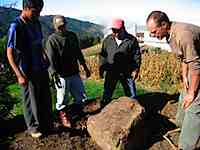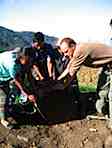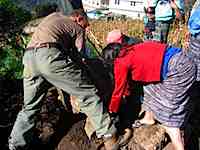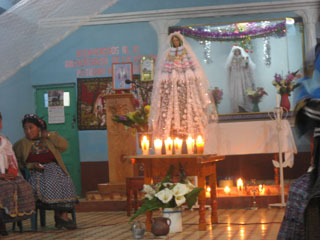
We mentioned the Virgin of Guadalupe earlier, but we’ve now successfully made it through her full festival full of interesting events and funny stories. The official celebrations began on Wednesday night and lasted until Friday night. You can bet there was non-stop marimba music from beginning to end. I don’t mean to be non-participatory in the culture, but that much marimba is enough to make me feel I HATE IT! When it finally ends, I can take a deep breath and move on…But I was about to tell you all some stories.
You should start off by knowing that the Virgin holds a particular significance to the Catholics here in Temux. You see, they’ve only had a Catholic church in the village for the last 14 years, and when they were able to build one they dedicated it to the Virgin. Nas Palas, as usual, told us this story sitting around their cooking fire as it burned down to coals. The Temuxenses credit the Virgin with saving their lives and their village during the civil war. It is said that one night in the midst of the conflict a few soldiers were guarding the colonel’s quarters in some undisclosed location of our municipio, when they spotted a young woman in indigenous dress, the typical Santa Eulalia blouse or huipil– it’s a white lacy affair with stripes of color around the collar–walking alone through the night. That may not sound like a big deal right off, but you need to understand at the time this was an unheard of thing to do. It was during a war. If you’re out at night, under cover of darkness, you’re automatically suspect for being up to no good, and she was a young woman, making her susceptible to beatings and rape. So the story goes that she walked up to the soldiers and asked to talk to the colonel, and amazingly enough she was granted permission to enter and speak with the man. She explained to him in simple terms that her people were a poor and humble people who had done nothing wrong. She made it clear to him that they should not be harmed in any way. And as our village heard the horror stories of what was happening in the nearby towns and villages, their village, and in fact our entire municipio went almost entirely unharmed, physically for the entire conflict. It is said that the señorita walking alone in the night was in fact the Virgin Mary, and that is why the church was named in her honor, and why the town celebrates the appearance of the Virgin of Guadalupe–that was the closest “legitimate” appearance of their guardian.
That said, we will get on to the party. It’s a big deal, about as big a deal as Guatemala’s Independence Day Celebration. The former, like the latter, involves sending a delegation of people to Panajachel to light a torch which they carry back with them to the village, and all the young delegates come running into town with torches lit from the flame that traveled north with them. It’s all very glorious. But we didn’t know about this part as we were hanging out in the family’s kitchen and someone asked if we were going dancing tonight, then someone asked if we were going to watch the torch come in to the village, then somehow the idea of a corte came up, then the corte–their traditional skirt– was talked about as a thing I would wear. And before I knew it, I was in the back room with all sorts of onlookers, men and women and children, as I changed/was changed into their traditional dress. Here you should know that women and men in town have been asking me since probably a week or so after our arrival when I was going to put my corte on. Apparently, this was the moment they’ve all been waiting for.
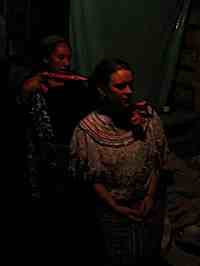 Reina led the effort, coming up with a new corte that, I think, belonged to her; finding me a suitable huipil and sweater; then braiding my hair. This is funny to me because Reina doesn’t like to be overly social. She doesn’t like dancing. She doesn’t really like participating in any religious celebrations. She likes to be at home with her family, keeping to herself when she’s not out working at the health center. Part of the reason I like her so much is that she has an opinion about things and more importantly, unlike most Guatemalans, she’ll share it with you HONESTLY–that’s a big deal to me. So although dressing me up didn’t really seem like it would be her “thing” she was surprisingly into the effort. During all of this Fletch and I had managed to lock ourselves out of our house. He and Galindo somehow got Galindo through the tiny window, which is located a good 15 feet off the ground, to unlock the door and bring me my grandma’s black loafers so I wasn’t wearing my hiking boots with the outfit. Reina braided the ribbons into my hair and as I put the huipil on while everyone watched and spoke quickly in q’anjob’al so that it was almost all entirely lost on me, little Michelle, who comes up to my knees, was looking up at me and stroking my newly dressed legs in amazement at the giant woman in chan, that’s dialect for corte. As she was looking up at me, her grandpa, Nas, was talking to her, and I saw in her very expressive face that her eyes bulged out for a moment frozen in time before she quickly looked away. “Que dijo, Nas?” I asked him what he said. “Nada,” he said with a smile. I kept asking everyone around me, “What did he say?!” I wanted to know why her eyes had turned the size of saucers, and no one would translate for me. Finally, Nas admitted, “I said, ‘Now she’s no longer Emily; she’s the Virgin of Guadalupe.'” That would do it. I had essentially turned to a ghost-like being in front of this nearly 3 year old girl. They had dressed the unwitting me as the picture of the señorita, their Virgin, who saved them all from an ugly fate. I remembered Chalio telling Reina the second day we were here that we must have fallen from heaven because he’d never seen people who looked like us before. Perfect, I thought, and now I’m the Virgin too. I am a virgo, but still.
Reina led the effort, coming up with a new corte that, I think, belonged to her; finding me a suitable huipil and sweater; then braiding my hair. This is funny to me because Reina doesn’t like to be overly social. She doesn’t like dancing. She doesn’t really like participating in any religious celebrations. She likes to be at home with her family, keeping to herself when she’s not out working at the health center. Part of the reason I like her so much is that she has an opinion about things and more importantly, unlike most Guatemalans, she’ll share it with you HONESTLY–that’s a big deal to me. So although dressing me up didn’t really seem like it would be her “thing” she was surprisingly into the effort. During all of this Fletch and I had managed to lock ourselves out of our house. He and Galindo somehow got Galindo through the tiny window, which is located a good 15 feet off the ground, to unlock the door and bring me my grandma’s black loafers so I wasn’t wearing my hiking boots with the outfit. Reina braided the ribbons into my hair and as I put the huipil on while everyone watched and spoke quickly in q’anjob’al so that it was almost all entirely lost on me, little Michelle, who comes up to my knees, was looking up at me and stroking my newly dressed legs in amazement at the giant woman in chan, that’s dialect for corte. As she was looking up at me, her grandpa, Nas, was talking to her, and I saw in her very expressive face that her eyes bulged out for a moment frozen in time before she quickly looked away. “Que dijo, Nas?” I asked him what he said. “Nada,” he said with a smile. I kept asking everyone around me, “What did he say?!” I wanted to know why her eyes had turned the size of saucers, and no one would translate for me. Finally, Nas admitted, “I said, ‘Now she’s no longer Emily; she’s the Virgin of Guadalupe.'” That would do it. I had essentially turned to a ghost-like being in front of this nearly 3 year old girl. They had dressed the unwitting me as the picture of the señorita, their Virgin, who saved them all from an ugly fate. I remembered Chalio telling Reina the second day we were here that we must have fallen from heaven because he’d never seen people who looked like us before. Perfect, I thought, and now I’m the Virgin too. I am a virgo, but still.
A funny side note: I really was not able to see how they tied me up in what is essentially yards and yards of fabric (think, same concept as a traditional Scottish kilt), with a belt. Because Reina wasn’t coming with us and I had no idea how to re-tie myself if it started coming loose, she tied me in there tightly. I haven’t felt so constricteded since I duct-taped my boobs down for a play in college that mixed up gender roles. Holy cow, I could hardly breathe. In the mean time Fletch had donned his capishay and hat, and we sat around stuffing down tortillas and beans to our host sisters’ urgings, “lim!”–hurry up! The torch was coming to town soon and they didn’t want to miss it. I did feel sort of like I was, again, in some bizarre play, acting the part of an indigenous woman in my traje, eating tortillas and beans around the fire with the family. As I waited in the mud and dark outside of our house, Nas’s tiny little niece walked up to me and said in an equally tiny whisper, “Emily, eres muy hermosa”–Emily, your very beautiful. Then she ran off in the dark.
We made it to the church in time to see the runners coming up from the bridge that marks the border of our village. Waiting in the dark, no one seemed to notice our clothing or rather notice that it was US in that clothing, but the moment we walked down in to the church yard we were greeted by the village mayor who led us past everyone (pretty intentionally past everyone he could think of), down behind the church to where a kitchen was FULL of women preparing a big dinner for all the participants of the celebration, the runners, the church leaders committee, and, apparently, us. My first thought was, “Crap, I just shoveled down a meal. I can’t breathe and now they’re gonna make me eat again.” 🙁 The crowd of women in the kitchen were, well, I think THRILLED would accurately describe their response to our outfits. The smiles on their faces could not have gotten any bigger; there was applause; the older women in the bunch came and hugged both of us in their gentle, awkward way (hugging doesn’t seem to be a natural gesture here, and I can’t quite explain it but to say that it’s very awkward, where the heads go, where the arms and hands meet, very awkward, but they do it because they mean well). The chikays, grandmas, in the room were so beside themselves they couldn’t speak. Some of the younger women we’ve gotten to know well through our health charlas just kept saying, “It’s so wonderful to see you dressed like, like us.” We hadn’t been running in the cold and dark with torches, but we had put on the traje, so we got seated and served first, and then many women took shifts watching us eat with near busting smiles. “Lowan, lowan, lowan!” They do this thing here, where while you’re eating, they tell you, “Eat, eat, eat,” as though you aren’t already, as if to say, “Go on, don’t be
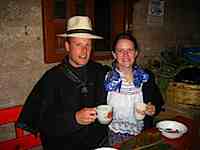 shy, dig in,” except you already are, so we just kept saying, “Thank you, thank you, thank you,” and methodically spooning the chicken soup in. All of our dinner company was excited to talk to us, test our knowledge of Q’anjob’al, and take pictures of us on their cell phones, not kidding, while two dead, recently-skinned sheep hung from the ceiling rafters off to our right. I knew they were recently skinned because the bones still had all the meat on them, and one sheep’s leg had slipped loose of the tie so it appeared to be dancing upside down from the rafter. Sometimes, things here are just very incongruous. Anyway, here is a picture of us in traje drinking our coffee. We picked up our cups so, as our photographer suggested, so “we can tell what you’re doing.”
shy, dig in,” except you already are, so we just kept saying, “Thank you, thank you, thank you,” and methodically spooning the chicken soup in. All of our dinner company was excited to talk to us, test our knowledge of Q’anjob’al, and take pictures of us on their cell phones, not kidding, while two dead, recently-skinned sheep hung from the ceiling rafters off to our right. I knew they were recently skinned because the bones still had all the meat on them, and one sheep’s leg had slipped loose of the tie so it appeared to be dancing upside down from the rafter. Sometimes, things here are just very incongruous. Anyway, here is a picture of us in traje drinking our coffee. We picked up our cups so, as our photographer suggested, so “we can tell what you’re doing.”
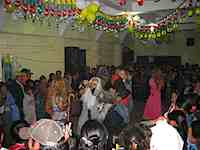 As dinner ended we headed back up to the church where every was congregating in the meeting hall. We waited outside a while for things to get settled in the salon and ended up talking with a woman we know well from the charlas, “You look like Mary and Joseph,” she said. I had to wonder why? Is this a bad thing because they see their god as a caucasion, or is this a good thing that they see their God wearing the traditional traje? I fear it’s more the former than the latter, but who really knows. One things for sure, me in a traje invokes images of the Virgin around here. We went into the salon and were given seats of honor on the stage until the beauty pageant began and they stuck us off the to the side, much to our relief. This was also a mini-version of the independence day beauty contest we judged in September. Thankfully, we weren’t judging this one, and the candidates and winners were all worked out beforehand, so there was just some 2 hours of handing over crowns and parading in and out of the salon. We were so tired, and I so could not breathe, as the whole thing seemed to finally be coming to an end. First came the convite, a dance of masked and costumed folk that is pretty traditional at every fiesta here. Why? We still have no idea. Among the demons and wizards was a George Bush mask, which made us laugh. Then the folk dancers came sweeping into the room with their handkerchiefs waving and bare feet jumping to get the music and dancing started. We were pulled in to the first round of dancing, and continued for 3 sets of marimba before we literally danced our way out the door and walked home under a big, full moon to go bed, way past our bedtime. And you should all know, we had no prior notice of anything other than dancing happening this night. We’re pretty much always in for surprises here.
As dinner ended we headed back up to the church where every was congregating in the meeting hall. We waited outside a while for things to get settled in the salon and ended up talking with a woman we know well from the charlas, “You look like Mary and Joseph,” she said. I had to wonder why? Is this a bad thing because they see their god as a caucasion, or is this a good thing that they see their God wearing the traditional traje? I fear it’s more the former than the latter, but who really knows. One things for sure, me in a traje invokes images of the Virgin around here. We went into the salon and were given seats of honor on the stage until the beauty pageant began and they stuck us off the to the side, much to our relief. This was also a mini-version of the independence day beauty contest we judged in September. Thankfully, we weren’t judging this one, and the candidates and winners were all worked out beforehand, so there was just some 2 hours of handing over crowns and parading in and out of the salon. We were so tired, and I so could not breathe, as the whole thing seemed to finally be coming to an end. First came the convite, a dance of masked and costumed folk that is pretty traditional at every fiesta here. Why? We still have no idea. Among the demons and wizards was a George Bush mask, which made us laugh. Then the folk dancers came sweeping into the room with their handkerchiefs waving and bare feet jumping to get the music and dancing started. We were pulled in to the first round of dancing, and continued for 3 sets of marimba before we literally danced our way out the door and walked home under a big, full moon to go bed, way past our bedtime. And you should all know, we had no prior notice of anything other than dancing happening this night. We’re pretty much always in for surprises here.
We’d canceled our language class the next day (and since then we’ve officially decided to never hold language class the day after there is to be any sort of celebration in town, because we don’t really get to sleep). The marimba that stopped at midnight started up again at 5 am, along with the bombas, exploding mortars, then there were town announcements over the loud speakers regarding…we have no idea, as we never do, because we can’t understand them. This was Thursday and there was supposed to be more dancing that night. The problem with having marimba music pulsing through town all day, if you want the gringos to come dance at night, is that by the time we’ve listened to it ALL DAY LONG we’re so sick of it there’s no way we want to get closer to it for dancing, come nighttime. So we decided to stay in and not go dancing. That was going well until one of our host sisters knocked on the door and, not asking, said, “Let’s go! Hurry up, the procession is starting!” Having no clear idea of what this was about, or what our roles in it would be, we just put on our warmest clothes and followed her out and down the road to the church. We got there in time to see a crowd of people walking up the narrow path from the 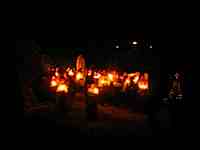 churchyard to the road with a statue of the Virgin hoisted on to some shoulders. The women had their shawls over their heads, arms full of cala lillies and bundles of daisies, hands full of think candle sticks all burning together like great wax torches. There were musicians following the statue leading religious songs in Q’anjob’al, which I could kind of understand, being mighty familiar with Catholic rhetoric and having already studied the appropriate words for family and body parts which are so often referenced. As the procession came upon us, an older lady handed me four candle sticks. I gave two to Fletch and we joined in the procession. The lines stopped moving every twenty feet or so to set off fireworks; bombas that echoed across the valley, lines of black jacks, roman candles, and occassionally the big fireworks we’re used to on the fourth of July shooting spiders of color across the sky, oh and whistlers shot around all around us, screaming as they went by, throughout the entire procession. As we stopped and started everyone struggled to keep their candles lit against the wind that was blowing a great mass of clouds in behind us. Women and children would pluck bundles of leaves off the side of the road to surround their candles, protecting them from the wind and eventually catching fire themselves, making the flame bigger and harder to put out. The moon was full and stars shone where there were no clouds, so while everyone’s faces where illumintated by the yellow candle light, looking beyond the procession we could see all the way across the valley to the mountains on the other side as low-lying clouds closed in around them below us.
churchyard to the road with a statue of the Virgin hoisted on to some shoulders. The women had their shawls over their heads, arms full of cala lillies and bundles of daisies, hands full of think candle sticks all burning together like great wax torches. There were musicians following the statue leading religious songs in Q’anjob’al, which I could kind of understand, being mighty familiar with Catholic rhetoric and having already studied the appropriate words for family and body parts which are so often referenced. As the procession came upon us, an older lady handed me four candle sticks. I gave two to Fletch and we joined in the procession. The lines stopped moving every twenty feet or so to set off fireworks; bombas that echoed across the valley, lines of black jacks, roman candles, and occassionally the big fireworks we’re used to on the fourth of July shooting spiders of color across the sky, oh and whistlers shot around all around us, screaming as they went by, throughout the entire procession. As we stopped and started everyone struggled to keep their candles lit against the wind that was blowing a great mass of clouds in behind us. Women and children would pluck bundles of leaves off the side of the road to surround their candles, protecting them from the wind and eventually catching fire themselves, making the flame bigger and harder to put out. The moon was full and stars shone where there were no clouds, so while everyone’s faces where illumintated by the yellow candle light, looking beyond the procession we could see all the way across the valley to the mountains on the other side as low-lying clouds closed in around them below us.
On top of all that, the guitar music was so simple and sweet that looking around, taking everything in, before I knew it I burst into tears and had to shut it off just as quickly for fear that someone would see me. People here are always worried that we might be sad because we miss our families or some such thing, and I didn’t want to ruin their procession by making them worry. We just kept walking as they said Hail Mary’s and sang songs, walking all the way up to the school entrance, before turning around and walking back to the church. The candles were getting low and the wind was getting stronger, so they’d go out, and we’d relight, then they’d go out again. Everyone was holding on until their candles were just the tiniest stubs. It was so cold the little heat they gave off helped keep our fingers warm, but I threw my down when they suddenly started to burn my fingers. Here is a picture of Fletch as he realized his fingers were burning too, so without thinking he threw his candle stubs and they landed, still lit, on the little girl in front of him. : ) Lucky for us, they think everything we do here is funny, so she just laughed hysterically in spite of us all trying to be appropriately solemn. Then she held my freed hands all the way back to the church, a big smile on her face. Ahh, those ridiculous gringos.
There was one more great display of pyrotechnics at the entrance to the church before placing the Virgin back on the altar. The statue’s entrance was followed by the congregation filing in and kneeling to begin their final prayers before the dancing began again. This was the moment I stayed by the back door and slipped away as the prayers started so I could go home and get in my warm bed again. I was not into the idea of dancing, but I was glad we’d come out for the procession, all thanks to Masha and her orders. It was really beautiful.
I stuck my earplugs in to block out the marimba and thought that I’d call it a night, which I managed to do pretty successful until about 3 in the morning. Our host mom came knocking on the door. Fletch heard her, and I couldn’t hear anything, but suddenly he was out of bed, the lights were on, and 4 women of various ages were standing in our kitchen. Since Fletch was running around I decided to play dumb and pulled the blankets over my head again.
He filled me in the next morning and I laughed hysterically at his story: when he opened the door to them calling my name they asked, “Podemos usar unos huevos?” and, though asking if they could have some eggs at this hour was a bit strange, he turned to pick up two eggs and as he turned around to hand them to Lina she had entered the house and looked at him like he was insane. She repeated, “Podemos usar tu fuego?” She wanted to use our stove because her cooking fire was out (it was, after all, 3 am). She pointed out to the yard where a young man was vomiting in the bushes. She explained it was her daughter’s brother-in-law, who is evangelical therefore ideally doesn’t drink, and someone had given him alcohol. He thought he was going to die, and they decided that giving him some warm beer would probably help the problem. Why? I have no idea. Can anyone out there tell me if this is a legitimate cure, we’ve also heard warm beer is a good thing to drink if you have diarrhea? I do know they couldn’t have given him cold beer because it was a cold night, and you should only drink warm things on cold nights or it will mess with your constitution. So Fletch turned a burner on and they warmed the beer in a tin cup and left us to go back to bed. We woke up about 15 minutes before our language instructor got here on Friday morning, pretty unexcited about class.
The marimba music and bombas had also begun at 5 am that morning, just as the day before. When Pedro showed up we explained all the weirdness (maybe it’s normal for him, but it’s definitely weird for us). He said, “Yeah, but they don’t play the music on those speakers all day and night.” We told him, in fact, they do. “They shouldn’t do that!” was his only response. We couldn’t agree more… Suddenly I saw a donkey walking down the road with yet MORE SPEAKERS attached to its back, headed in the direction of the church. I told Fletch and he ran out with his camara in hand. All I could think was, “Ay, mundo…” which is a colloquial expression that means roughly, “oh, lord.” We did all we could about that situation. Which is to say we made some pancakes and coffee and sat out in the sun where it was warm to eat it all and, of course, listen to the marimba. I couldn’t have felt less excited about the two hours of class we were supposed to have after breakfast.
As we were finishing up breakfast we noticed our host family across the way was trying to move their huge laundry stone back up the hill and next to the stream. When the digger came to level out spaces for new houses a week ago, the stone was moved and then covered in dirt, but it’s a pretty perfect stone on which to wash clothes so they’d decided to try and rescue it. Pedro and Fletch went flying over to help them out.
This is when I decided there was absolutely no way I was going to sit inside for class this beautiful day. I told Pedro so, and explained that we should sit around with the family while they speak in Q’anjob’al and try and figure out what they’re saying. He could guide the conversation around to things we’ve studied so far. Thus we sat outside in the sun under a beautiful blue sky and had what was the closest thing to our first conversation with our host family in their language. It was a good day even if we were forced to listen to marimba for the duration of it. We did not go dancing the last night of festival. Instead, we went to bed early and prayed no one would wake us up neither for eggs nor fire. And thus ended the festival of La Virgin de Guadalupe.
